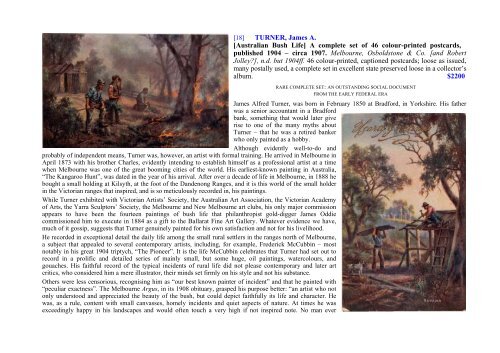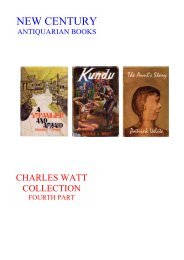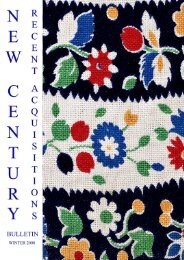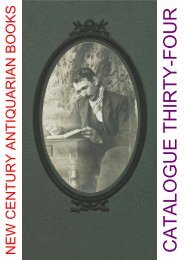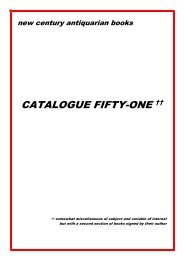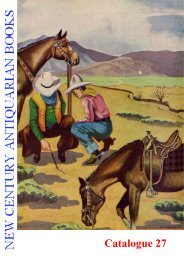Catalogue 63 New Century Antiquarian Books Late Spring 2012
Catalogue 63 New Century Antiquarian Books Late Spring 2012
Catalogue 63 New Century Antiquarian Books Late Spring 2012
You also want an ePaper? Increase the reach of your titles
YUMPU automatically turns print PDFs into web optimized ePapers that Google loves.
[18] TURNER, James A.<br />
[Australian Bush Life] A complete set of 46 colour-printed postcards,<br />
published 1904 – circa 1907. Melbourne, Osboldstone & Co. [and Robert<br />
Jolley], n.d. but 1904ff. 46 colour-printed, captioned postcards; loose as issued,<br />
many postally used, a complete set in excellent state preserved loose in a collector’s<br />
album.$2200<br />
RARE COMPLETE SET: AN OUTSTANDING SOCIAL DOCUMENT<br />
FROM THE EARLY FEDERAL ERA<br />
James Alfred Turner, was born in February 1850 at Bradford, in Yorkshire. His father<br />
was a senior accountant in a Bradford<br />
bank, something that would later give<br />
rise to one of the many myths about<br />
Turner – that he was a retired banker<br />
who only painted as a hobby.<br />
Although evidently well-to-do and<br />
probably of independent means, Turner was, however, an artist with formal training. He arrived in Melbourne in<br />
April 1873 with his brother Charles, evidently intending to establish himself as a professional artist at a time<br />
when Melbourne was one of the great booming cities of the world. His earliest-known painting in Australia,<br />
“The Kangaroo Hunt”, was dated in the year of his arrival. After over a decade of life in Melbourne, in 1888 he<br />
bought a small holding at Kilsyth, at the foot of the Dandenong Ranges, and it is this world of the small holder<br />
in the Victorian ranges that inspired, and is so meticulously recorded in, his paintings.<br />
While Turner exhibited with Victorian Artists’ Society, the Australian Art Association, the Victorian Academy<br />
of Arts, the Yarra Sculptors’ Society, the Melbourne and <strong>New</strong> Melbourne art clubs, his only major commission<br />
appears to have been the fourteen paintings of bush life that philanthropist gold-digger James Oddie<br />
commissioned him to execute in 1884 as a gift to the Ballarat Fine Art Gallery. Whatever evidence we have,<br />
much of it gossip, suggests that Turner genuinely painted for his own satisfaction and not for his livelihood.<br />
He recorded in exceptional detail the daily life among the small rural settlers in the ranges north of Melbourne,<br />
a subject that appealed to several contemporary artists, including, for example, Frederick McCubbin – most<br />
notably in his great 1904 triptych, “The Pioneer”. It is the life McCubbin celebrates that Turner had set out to<br />
record in a prolific and detailed series of mainly small, but some huge, oil paintings, watercolours, and<br />
gouaches. His faithful record of the typical incidents of rural life did not please contemporary and later art<br />
critics, who considered him a mere illustrator, their minds set firmly on his style and not his substance.<br />
Others were less censorious, recognising him as “our best known painter of incident” and that he painted with<br />
“peculiar exactness”. The Melbourne Argus, in its 1908 obituary, grasped his purpose better: “an artist who not<br />
only understood and appreciated the beauty of the bush, but could depict faithfully its life and character. He<br />
was, as a rule, content with small canvasses, homely incidents and quiet aspects of nature. At times he was<br />
exceedingly happy in his landscapes and would often touch a very high if not inspired note. No man ever


